Previously on Baxter Building: Having successfully created the Marvel Universe as we know it with the first four years of Fantastic Four, Stan Lee and Jack Kirby’s ambitions have apparently only grown with the introduction of the Inhumans and, in the very first issue we’re about to talk about, the first appearance of the Silver Surfer and his very, very hungry boss.
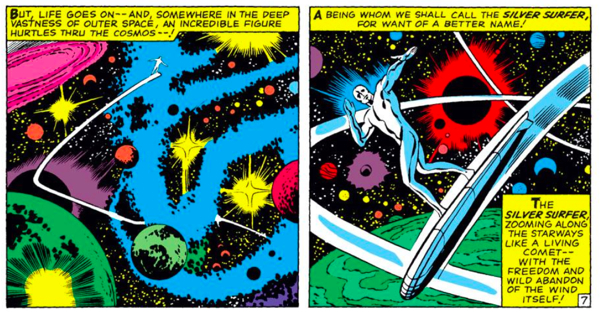
0:00:00-0:00:47: A metatextual cold open, in which I tease the cold open that you don’t get to hear — unless you’re a Patreon supporter, because, yes, the cold open that I talk about is available in the digital grab bag as a supporter extra for those who want to hear what kind of a week I had last week.
0:00:47-0:07:41:Jeff and I introduce the contents of the episode — we’re covering Fantastic Four #48-53 in this episode, although we say that we’re doing #54 repeatedly; chalk that up to optimism in the fact that, maybe, we wouldn’t talk too much this time around. Oh, if only! This is Lee and Kirby’s FF in “full effect,” as Jeff puts it, and we launch straight into it by discussing what Joe Sinnott brings to the artwork of Jack Kirby. (Jeff references this comment by Archibald at one point, in talking about Sinnott bringing the look of Kirby and John Romita closer together.) You can’t just put it down to Sinnott alone, however; we also discuss the fact that Kirby’s art is starting to feel like the same artist who worked on things like New Gods, The Eternals and Captain America in the 1970s in passing.
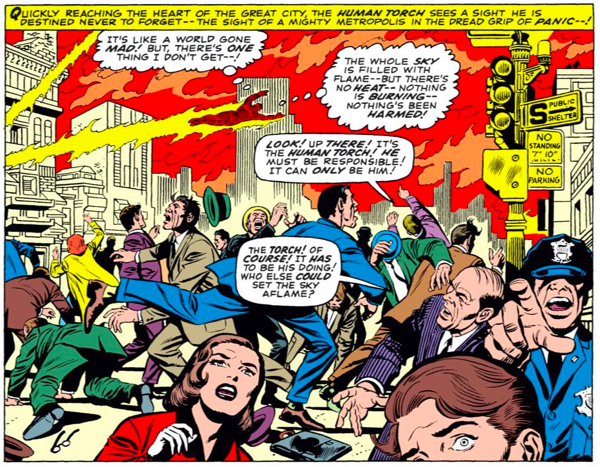
0:07:42-0:19:25: We return to Fantastic Four No. 48 right where we left it, with the team escaping Attilan as it gets shut away from the rest of the world “forever.” In fact, we return exactly where we left off, talking about how much Stan Lee adds to the beautiful, yet occasionally narratively unhelpful, Kirby aesthetic. Also under discussion: Does this issue set up today’s superhero comic by being an entire issue of foreboding for an event that only happens on the very last page? I argue against that theory because of the amount of action on offer, but feel free to disagree in the comments below. And is Stan Lee accidentally setting up the idea that Reed and Sue are the most dysfunctional marriage in the Marvel Universe? (Spoiler: Yes.)
0:19:26-0:23:58: Whether intentionally or otherwise, the pacing of this issue really adds to the feeling that events are happening out of control, but Jeff would rather talk about the fact that the Fantastic Four are quietly becoming guest stars in their own series — and why that’s a good thing.
0:24:59-0:36:06: FF #49 “is such a weird issue,” I say, and a lot of that is down to the surreal pacing of the whole thing, which includes this scene:
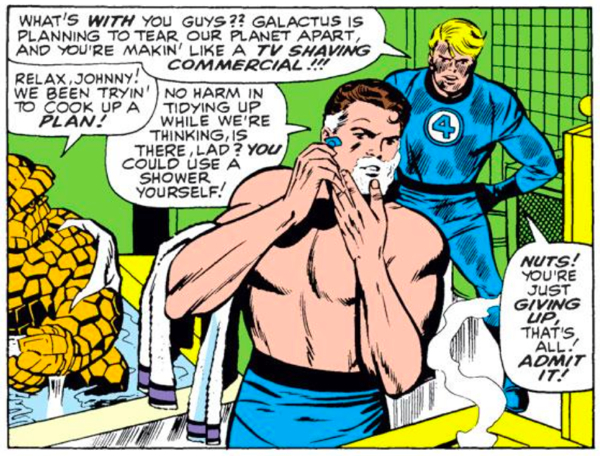
Only in Lee and Kirby’s FF would you get a bath scene with the Thing in the middle of such an epic story as the Galactus saga. Jeff makes a really impressive case for this being a character moment instead of just a comedy moment, before he talks about the ways in which the issue lays the groundwork for not only Jack Kirby’s DC career but also Steven Spielberg’s. We get back to what Stan Lee brings to these issues, as well, with my describing this era of the series as a confidence trick (albeit a really enjoyable one), and comment on the fact that the Silver Surfer looks a little more alien than he’ll later become at this point…
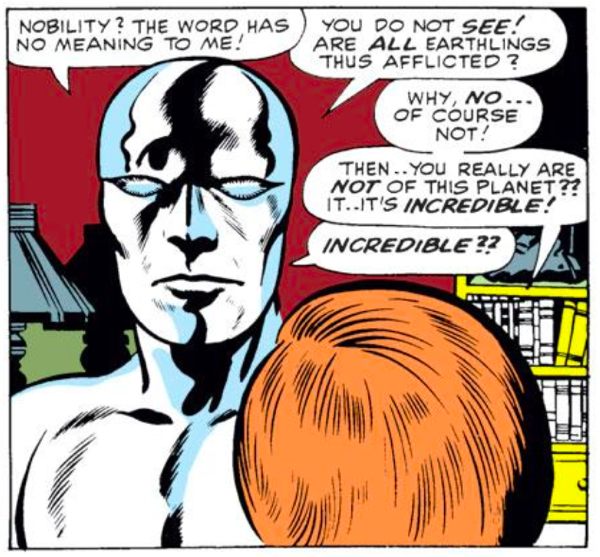
0:36:07-0:46:09: How on fire are Lee and Kirby at this point? On fire enough that scenes in which neither are doing their best work, and yet, somehow it works nonetheless. Is it because Kirby is subconsciously channeling fairy tale logic yet again? (If there’s one unconscious theme of Baxter Building to date, it’s that Fantastic Four by Lee and Kirby is a series of fairy tales.) Is it the basic design of the Silver Surfer on the whole, and the way in which the body language of the character underscores his calm demeanor? The best Galactus, by the way? The melodramatic one, despite what Jeff thinks.
0:46:10-0:56:09: We arrive at what just might be the highpoint of Lee and Kirby’s Fantastic Four, at least in terms of the out-there, expansive nature of the pair’s storytelling and ambition, as the Watcher sends Johnny beyond the known on a secret mission. Kirby and Sinnott’s visuals approach abstract genius, and Lee comes up with something to match (including an unknowing shoutout to Kirby’s latter Fourth World work). It’s trippy, disconnected from everything else in the issue, subverting narrative expectations — Jeff’s detour about the way in which this subplot rejects Joseph Campbell and is reminiscent of Blue Velvet of all things is fascinating — and all the better for it. This is the way out, whatnauts. (Enjoy a surprise cameo from Gus and Ernie midway through this conversation, too.)
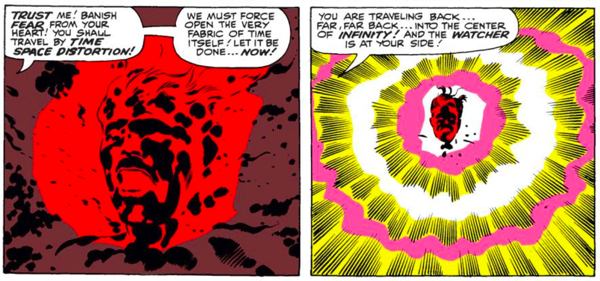
0:56:10-1:16:31: “Greater than the greatest” is how Stan Lee describes the 50th issue of Fantastic Four, and he’s… not entirely wrong, despite the fact that this issue is a letdown compared with the first two issues of this storyline. How does this issue connect with Bob Layton and Squirrel Girl? The answer may surprise you! Once again, Stan steps up to make sense of some of Kirby’s more narratively-confusing panel-to-panel coherent, and then introduces the concept of moral relativism to the Fantastic Four when you least expect it, while the Watcher all of a sudden looks like a bad guy:
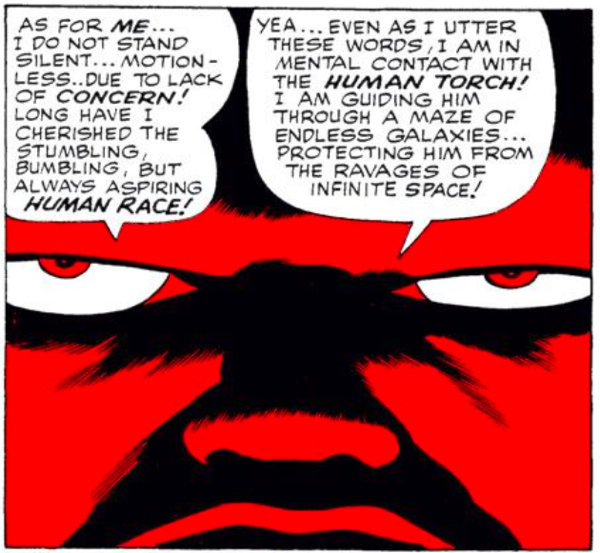
Johnny returns from beyond with… a Macguffin, and I’m not happy about that, although it works for Jeff (in part because it plays into Kirby’s tendency to fudge his endings and rely on what came before for emotional impact). What’s the story all about, anyway? Not the ultimate fate of the planet, if the real climax of this issue is anything to go by: oh, Silver Surfer, you deserved better… maybe? Plus! The previously unknown connection between Fantastic Four #50 and Multiversity!
1:16:32-1:20:43: “Not to put you on the exhibit stand,” Jeff says before asking putting me on trial and asking me how I would have preferred to see this storyline end. Well, I did say that I thought the end of the story was unsatisfying. My lesson has been learned for the future, don’t you worry.
1:20:44-1:28:07: Ben Grimm is a self-involved dick, ladies and gentlemen, but we love him nonetheless (Still, pay more attention to Alicia, Ben!). More importantly, FF #50 features the first appearance of one of my favorite Marvel Universe characters: Wyatt Wingfoot, who singlehandedly redeems the amazing amount of filler that closes out the issue.
1:28:08-1:29:11: In which we arrive at “This Man, This Monster,” Fantastic Four #51 and probably my favorite issue of the series. Not that it started out that way, as I explain my secret origin with the story.
1:29:12-1:45:52: Jeff makes a reference to this Wait, What? art from Gar Berner, which is just great:
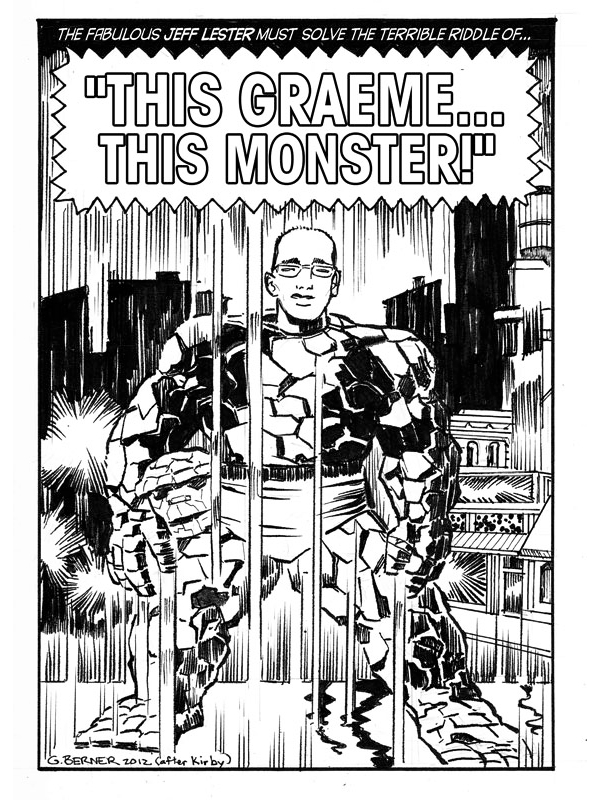
Isn’t that such an amazing piece? And riffing on one of the finest splash pages in the series to date, as Kirby and Sinnott bring their A game entirely. “You can read the expression on his face as just the deepest desolation,” Jeff puts it, which is entirely true. Who doesn’t love this page? Who doesn’t love this issue in general? Under discussion in this issue: the wonderful art, the plight of Ben Grimm’s helplessness and the fact that it’s not a story about any of the Fantastic Four at all. (Remember what Jeff was saying about the FF becoming guest stars in their own series?) Also, what can the fake Thing teach us all about self-belief and self-determination, and what — if anything — did it teach Stan Lee about same? It’s a very different type of story than the earlier three issues, but none the less for that.
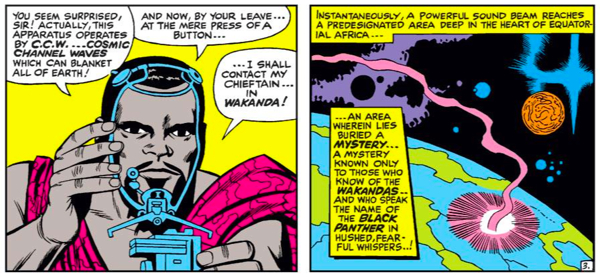
1:45:53-2:00:51: Fantastic Four #52 introduces the Black Panther (in a story called, of course, “The Black Panther!”) and, as Jeff puts it, ushers in a world of “Psychedelic Afro-Futurism,” and somehow it still comes across as painfully racist. Not as much as the next issue, admittedly, but these two issues are impressive examples of how the best intentions of those laboring under a particularly troublesome mindset/societal outlook are still very much shot through with all those troublesome elements when viewed from more “enlightened” times (Insert sad, bitter joke about how much more enlightened about race we are today.) The T’Challa on show in this debut issue is very different from the one we’ve come to know and love, and that’s discussed for awhile, in between my constant fretting about racism (and pointing out that the Inhumans are back, although they never really went away). Far more fun: Jeff explaining what college is, and why Lee and Kirby get college so very, very wrong.
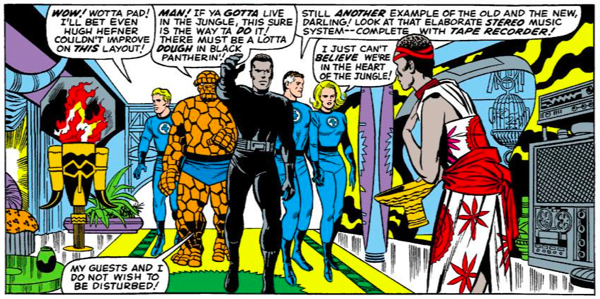
2:00:52-2:09:12: If you’ve been waiting for the Fantastic Four to be the super team of white privilege, then Fantastic Four #53, “The Way It Began,” is the issue for you! Ben can’t be bothered listening to the Black Panther’s origin story because he’s read Tarzan stories! Sue Storm can’t believe Africa has technology! Do the Wakandans have any true agency in their first appearance, and is it enough to overpower everything that’s distasteful about the issue? For Jeff, the answer is yes, and as I argue against that reading, the sound quality starts to fade, meaning that I pop in and out. Consider it a blessing in disguise, perhaps…?
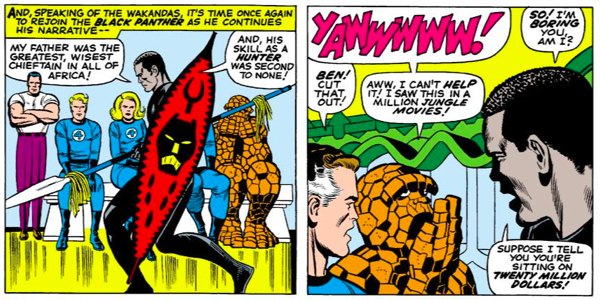
2:09:13-end: We start to talk about FF #54, mostly to continue to talk about the racism in the issue, before taking a powder for reasons of running time and poor call quality. Next time, we’ll talk about #54-60 of the series, matching our impressively lengthy discussions and trying to stay slightly more on-topic. Will we succeed? Who can tell? In the meantime, keep up with us on Tumblr, Twitter and Patreon, and I apologize for sickness meaning I was especially lax with the Tumblring and the written post last week. Those of you with access to the Patreon supporter grab bag will, at least, get to know why in horrifying detail. We’ll be back with another Baxter Building in a month, but before then, another Wait, What? in two weeks. Miss them never, true believers.


Because Jeff’s not around to do it: You can download the episode for yourself from here!
http://theworkingdraft.com/media/podcasts/BaxterBuildingEp5.mp3
Unfortunately, I won’t get a chance to listen to the latest podcast for another week, as I’m freelancing in an office this week and I always like to listen to podcasts when working at home. But a ccouple of thoughts on my altime favourite period of the Fantastic Four.
“What’s the story all about, anyway?”
One of my favourite reviews of the first Galactus/Silver Surfer story was from a UK fanzine I read back in the 80’s which described it as the God of the Old Testament (Galactus, full of wrath and judgement) versus the God of the New Testament (the Watcher, full of love and unwilling to interfere directly) with the Surfer as Jesus in the middle, punished for the sins of mankind.
No idea if that really is the case or not, but it’s a great idea! The review then went in to ponder whether in the next Surfer story (in 55-60) Dr Doom is Lucifer.
“This Man, This Monster is superb. ‘Nuff said.
In regards to the Fnatastic Four being guest stars in their own title, I’d very much agree with you, and believe that is very much down to the tension between Kirby’s short attention span and Lee’s belief in narrative drive. In short, Lee reigns in Kirby’s desire to go off in multiple directions, which has a tendency to abandon the lead characters in his solo stories. I actually think this is one of the things that makes the thirty or so issues that begin with the Inhumans Saga the apex of the Fantastic Four. They are there to add humanity and continuity, but work best as observers to the fairY tale events around them. it’s something that pretty well every writer has either ignored every since, or failed to get the balance right. Hickman, for all his faults, came close. Waid seemed to understand it best, although seemed more interested in telling more traditional superhero stories.
I also think that the idea of the Fnatastic Four being guest stars in their own comic is all but impossible to pull off in these days of decompressed comics. I wonder whether this is part of why the Fantastic Four are such a hard sell in today’s comic’s market?
The Galactus trilogy is also an answer to a lot of Lee’s critics, in my opinion: he seems always to be portrayed as expoiting his artists and denying them true credit for things, yet from almost the beginning Lee was frank about the Surfer being Kirby’s creation, never asked for by Lee, but mesmerising him none the less.
Anyway, keep up the good work, and sorry about the long post.
People always bring up the unfair treatment of the Kirbys with respect to the Avengers franchise. But one of Kirby’s other creations has also gone on to great multimedia success, and nobody seems to be complaining that the family doesn’t see any of the rewards. I’m talking of course about the Punisher. Three feature films and not a dime to the Kirby estate. It’s a travesty.
In protest, I’ve made a point to never read a Punisher comic not drawn by Kirby. It’s a small sacrifice; I’m sure I’m not missing much.
Re: The original Silver Surfer differing from later incarnations, including those written by Lee. This was a topic of an essay written by recently-linked-to, friend-of-the-podcast Tim O’Neil. It kind of serves as a nice counterpoint to the interpretation mentioned by Carey (i.e. Tim’s argument would say the idea of Surfer as Space Jesus in the original Galactus Saga is a bit of revisionist history).
http://whenwillthehurtingstop.blogspot.com/2013/11/there-are-two-silver-surfers.html
Wikipedia is wrong?
“The Punisher is a fictional antihero that appears in comic books published by Marvel Comics. The character was created by writer Gerry Conway and artists John Romita, Sr., and Ross Andru, with publisher Stan Lee providing the name. The Punisher made his first appearance in The Amazing Spider-Man #129 (cover-dated Feb. 1974).”
https://en.wikipedia.org/wiki/Punisher
I thought Ben Grimm’s disinterest in the Panther’s origin was pretty in-character.
The depiction of Wakanda is not unlike the depiction of Eastern Europe. It’s definitely well-meaning and probably springs from Kirby’s genuine interest in other cultures. But he and Lee were cranking these things out. There wasn’t time for research, so most of it is informed by pop culture and whatever general (mis)conceptions were floating around at the time. Whatever bits of racism crop up in the story (and imo, there are impressively few for the time), they’re surely ignorance, not hate.
I agree very much about Cass’s points on the embedded racism of these issues. So much of everything in the Silver and Golden age of comics was taking from pulp magazines of the past. To me everything in the Wakanda sequence was playing off of that–just the fact that they played with pulp cliches and tried to flip them on their head rather than just replicate them was a big deal, to my way of reading it.
Grahame looks at the white pianist and sees a racist assumption about who can play classical music, I see a flipping of expectations, were you find a society deep in the jungle that can casually afford to fly their entertainment from the highest rungs of European culture on a whim…reversing the rich white person bringing in the “native” entertainment…
I saw a good percentage of the unfortunate comments in the Panther issues as representing the cultural expectations of the readers, highlighted specifically to subvert them. Graeme may have preferred Wakanda’s advancement being unremarked upon, but would readers steeped in jungle cliches have GOTTEN that? Instead, we have all this, “Wow, savages” dialogue being answered, essentially, with “Yeah, they’re much more than you expected.” I like that (though it’s not always pulled off well.)
(I say this uncomfortably, because being a white guy finding ways to let white creators off the hook on this … feels like I’m compromised,)
Curiously, Wakanda’s advancement here is all about T’Challa’s vibranium spending. Isn’t it later retconned to be that Wakanda spent centuries advancing as it naturally should’ve, because Euro-US slave trade/colonial exploitation didn’t utterly disrupt it?
So, given this is really the beginning of Marvel’s moving towards characterising abstract concepts as characters, can we draw a line from Galactus to Starlin’s later work?
And if so, it’s interesting that the FF issues are very much “people on a smaller scale contemplating the Macroscosm” whereas Starlin’s work is “Personified abstract concepts contemplating the minutiae of existence.”
Given that Eternity appears for the first time in Strange Tales #138, which came out November 1965, four months before Galactus turns up, and Starlin’s obvious love of Ditko there’s at least a few wiggles in that line!
Drat, I figured some time after I hit “post” my timeline was a bit wonky and something sufficiently cosmic (or proto-cosmic) had shown up either in Strange or Thor.
Though given that Strange is more conversant with these strange beings, it’s probably a different dynamic at work as here, given how much the FF are basically “the people you know, but with powers.”
A feeble differentiation, sure, but it’s the best I got.
If Graeme has never read What If#41 “What If the Avengers Had Fought Galactus,” then I suggest he do so – Jim Valentino borrows liberally from Kirby’s images in the original Galactus story and develops an interesting version of the tale where, because of it being a reality where the FF don’t exist, the Avengers have to face Galactus, except they fail at everything where the FF succeeded; in the end, the Watcher breaks his oath in order fight Galactus one-on-one; Galactus wins and instead of eating the Earth, he consumes the Watcher.
The remark about Reed & Ben differing from Johnny because they both have combat experience from WWII makes me wonder – is there any basis for a reading of Kirby intending the Torch to be his version of Stan? Given that Kirby saw himself as the Thing, is it possible he interpreted Johnny as the bratty teenaged non-combatant he originally knew Lee as? If there’s even one panel of Johnny playing a flute, that would clinch it.
Regarding the above image of the Wakandan contacting his homeland on a small handheld device, Christopher Priest loved that moment because the FF were, essentially, fawning over him for owning a cellphone (T’Challa’s Kimoyo card in the Priest run was the next generation of the CCW device – essentially, the Wakandan iphone came out before the US version).
[Stu stops in at McDonald’s for some food]
STU: Oh wow, a new episode of Baxter Building!
[lifts Big Mac to take first bite]
PODCAST: So I thought we should start off by talking about laxatives and poo…
I kind of love your idea that of the Inhumans coming back to rob banks because they’re being controlled by the Puppet Master. Hilarious and terrible.
Also, you might want to include Annual #4 for next episode. It apparently falls in between issues 56 and 57.
And not really related, but I started reading the first Showcase Presents volume of Legion of Super Heroes, which collects issues that were coming out at about the same time as Fantastic Four (early 1960s). I have pretty limited experience with this era of comics, but seeing what else was available at the time really makes the stuff Marvel was putting out seem more impressive.
I love you guys’ notion that Johnny was permanently broken by his voyage to get the Ultimate Nullifier, thus explaining his legendary immaturity as a coping mechanism for the trauma he never actually confronted. It’s a sublime explanation for the nature of an otherwise two-dimensional character, even if it’s never been explicitly addressed.
It reminds me of your discussion of Englehart’s Avengers, and how Beast’s transition from savage, brooding Proto-Wolverine to wacky bouncing prankster was the result of going to California and (presumably) smoking his massive weight in weed. If only more Marvel writers could go for these simple yet sympathetic and human explanations for character changes, as opposed to not bothering or coming up with some kind of stupidly contrived “yellow fear demon” excuse.